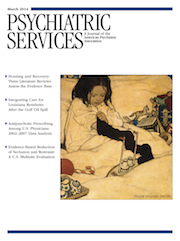This Month’s Highlights
Focus on Housing and Recovery
This month’s issue features three literature reviews on housing that highlight the importance of secure housing in recovery from serious mental illness. In the lead article, Debra J. Rog, Ph.D., and colleagues review the evidence base for permanent supportive housing, a much-studied intervention that provides affordable long-term housing to people with serious mental illness. Residents are also offered supportive services, but housing is not contingent on their service participation (page Original article: 287). In the second review, Sharon Reif, Ph.D., and colleagues examine research on recovery housing, which provides supervised short-term housing to help stabilize people with substance use disorders so that they can take their first steps toward recovery in a supportive environment. The authors found many gaps in the research base and recommend areas for further study (page Original article: 295). The third review, also by Dr. Reif and her colleagues, looks at residential treatment for individuals with substance use disorders, an intervention that provides a 24-hour level of structured care in nonhospital, freestanding facilities and allows residents to focus on intensive recovery activities. Residential treatment models vary widely, and the traditional 28-day model is fairly rare today. The authors echo the call of others for more rigorous research with greater specificity and consistency (page Original article: 301). The three articles are part of the SAMHSA-funded Assessing the Evidence Base Series, which updates research on commonly used interventions for people with serious mental illness. The articles, which were peer reviewed by a special panel of Psychiatric Services reviewers, will appear in the journal throughout 2014. Commenting on the three articles in Taking Issue, Sam Tsemberis, Ph.D., founder of Pathways to Housing, Inc., which developed the Housing First model, notes that an effective housing model “must be based on core principles and values: housing as a basic right, social inclusion, and equal access to social, cultural, educational, and employment opportunities.” Finally, in this month’s Open Forum, Kevin Martone, M.S.W., describes a housing crisis for people with serious mental illness—a crisis that occurs when the average national rent for a one-bedroom unit began exceeds the average monthly income of an individual receiving Supplemental Security Income. The consequences of the nation’s failed housing policy—incarceration and chronic homelessness—are often unfairly blamed on the public behavioral health system, the author notes (page Original article: 313).
Integrated IMR for Older Adults
Illness Management and Recovery is an evidence-based practice that helps people with serious mental illness acquire knowledge and skills to develop greater mastery over their symptoms and to set meaningful recovery goals. A study by Stephen J. Bartels, M.D., M.S., and colleagues evaluated the feasibility and effectiveness of integrated IMR (I-IMR), an intervention that extends the intervention to the self-management of chronic general medical conditions. The authors conducted a randomized controlled pilot trial comparing I-IMR to usual care for 71 middle-aged and older adults who had serious mental illness and a comorbid general medical condition. I-IMR was associated with greater improvements in self-management of psychiatric illness, greater diabetes self-management, and fewer hospitalizations (page Original article: 330).
Targeting Seclusion and Restraint
Seclusion and restraint are controversial procedures generally considered to be interventions of last resort. Increasing numbers of consumers, advocates, and providers hold that even the tight current restrictions on use of these procedures allow too much latitude. An article by Dow A. Wieman, Ph.D., and colleagues presents results of a study that examined rates of seclusion and restraint over four years at 43 facilities and programs that were implementing the clinical model Six Core Strategies to Prevent Conflict and Violence (6CS), a prevention-based staff training curriculum. Facilities that achieved stable implementation of 6CS and fidelity to the model, the authors found, reduced the percentage of patients restrained by 30% and the number of restraint hours by 55%. Corresponding reductions for seclusion were 17% and 19%, respectively (page Original article: 345).
Which Is More Coercive: AOT or MHCs?
Jurisdictions use two main approaches to mandate treatment through the courts: assisted outpatient treatment (AOT) and mental health courts (MHCs). Mark R. Munetz, M.D., and colleagues interviewed participants in both types of program and concluded that both have coercive aspects. However, MHC participants reported lower levels of perceived coercion, compared with AOT participants, and higher levels of procedural justice. The authors found that judges who actively and respectfully engage with MHC participants strongly influence their perceptions, which may improve long-term outcomes (page Original article: 352).



